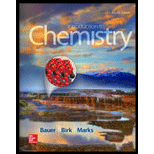
Concept explainers
(a)
Interpretation:
The given
(a)
Explanation of Solution
The given reaction is,
The reactant side contains
(b)
Interpretation:
The given chemical reaction is to be balanced.
(b)
Explanation of Solution
The given reaction is,
The reactant side contains
(c)
Interpretation:
The given chemical reaction is to be balanced.
(c)
Explanation of Solution
The given reaction is,
The reactant side contains
(d)
Interpretation:
The given chemical reaction is to be balanced.
(d)
Explanation of Solution
The given reaction is,
The reactant side contains
(e)
Interpretation:
The given chemical reaction is to be balanced.
(e)
Explanation of Solution
The given reaction is,
The reactant side contains
Want to see more full solutions like this?
Chapter 5 Solutions
Introduction to Chemistry
- The sugar sucrose, which is present in many fruits and vegetables, reacts in the presence of certain yeast enzymes to produce ethanol and carbon dioxide gas. Balance the following equation for this reaction of sucrose. C12H22O11(aq) + H2O(l) C2H5OH(aq) + CO2(g)arrow_forwardBalance the following equations: (a) PCl5(s)+H2O(l)POCl3(l)+HCl(aq) (b) Cu(s)+HNO3(aq)Cu( NO3)2(aq)+H2O(l)+NO(g) (c) H2(g)+I2(s)HI(s) (d) Fe(s)+O2(g)Fe2O3(s) (e) Na(s)+H2O(l)NaOH(aq)+H2(g) (f) ( NH4)2Cr2O7(s)Cr2O3(s)+N2(g)+H2O(g) (g) P4(s)+Cl2(g)PCl3(l) (h) PtCl4(s)Pt(s)+Cl2(g)arrow_forwardBalance the following equations. a NaOH + H2CO3 Na2CO3 + H2O b SiCl4 + H2O SiO2 + HCl c Ca3(PO4)2 + C Ca3P2 + CO d H2S + O2 SO2 + H2O e N2O5 NO2 O2arrow_forward
- Balance the following equations: (a) for the synthesis of urea, a common fertilizer CO2(g) + NH3(g) NH2CONH2(s) + H2O() (b) for the reactions used to make uranium(V1) fluoride for the enrichment of natural uranium UO2(s) + HF(aq) UF4(s) + H2O() UF4(s) + F2(g) UF6(s) (c) for the reaction to make titanium() chloride, which is then converted to titanium metal TiO2(s) + C12(g) + C(s) Ti(s) + CO(g) TiC14() + Mg(s) Ti(s) + MgC12(s)arrow_forwardAluminum carbide, Al4C3, reacts with water to produce methane, CH4. Al4C3(s) + 12 H2O(l) 4 Al(OH)3(s) + 3 CH4(g) 1. If 125 g of aluminum carbide is decomposed, what is the theoretical yield of methane? (a) 4.64 g (b) 13.9 g (c) 415 g (d) 154 garrow_forwardBalance the following equations representing combustion reactions: a. b. c. C12H22O11 (s) + O2(g) CO2 (g) + H2O (g) d. Fe(s) + O2(g) Fe2O3(s) e. FeO(s) + O2(g) Fe2O3(s)arrow_forward
- Methane (CH4) is the main component of marsh gas. Heating methane in the presence of sulfur produces carbon disulfide and hydrogen sulfide as the only products. a. Write the balanced chemical equation for the reaction of methane and sulfur. b. Calculate the theoretical yield of carbon disulfide when 120. g of methane is reacted with an equal mass of sulfur.arrow_forwardBalance these equations. (a) UO2(s) + HF() UF4(s) + H2O() (b) B2O3(s) + HF() BF3(g) + H2O() (c) BF3(g) + H2O() HF() + H3BO3(s)arrow_forwardBalance the following equations. a Sn + NaOH Na2SnO2 + H2 b Al + Fe3O4 Al2O3 + Fe c CH3OH + O2 CO2 + H2O d P4O111 + H2O H3PO4 e PCl5 + H2O H3PO4 + HClarrow_forward
- 3.11 Balance these equations. (a) Al(s) + O2(g)( Al2O3(s) (b) N2(g) + H2(g) (NH3(g) (c) C6H6(l) + O2(g) ( H2O(l) + CO2(g)arrow_forwardSilicon is produced for the chemical and electronics industries by the following reactions. Give the balanced equation for each reaction. a. SiO2(s)+C(s)arefurnaceElectricSi(s)+CO(g) b. Liquid silicon tetrachloride is reacted with very pure solid magnesium, producing solid silicon and solid magnesium chloride. c. Na2SiF6(s) + Na(s) Si(s) + NaF(s)arrow_forwardTungsten (W) metal, which is used to make incandescent bulb filaments, is produced by the reaction WO3+3H23H2O+W How many grams of H2 are needed to produce 1.00 g of W?arrow_forward
 General, Organic, and Biological ChemistryChemistryISBN:9781285853918Author:H. Stephen StokerPublisher:Cengage Learning
General, Organic, and Biological ChemistryChemistryISBN:9781285853918Author:H. Stephen StokerPublisher:Cengage Learning Introductory Chemistry: A FoundationChemistryISBN:9781285199030Author:Steven S. Zumdahl, Donald J. DeCostePublisher:Cengage Learning
Introductory Chemistry: A FoundationChemistryISBN:9781285199030Author:Steven S. Zumdahl, Donald J. DeCostePublisher:Cengage Learning Chemistry for Engineering StudentsChemistryISBN:9781337398909Author:Lawrence S. Brown, Tom HolmePublisher:Cengage Learning
Chemistry for Engineering StudentsChemistryISBN:9781337398909Author:Lawrence S. Brown, Tom HolmePublisher:Cengage Learning General Chemistry - Standalone book (MindTap Cour...ChemistryISBN:9781305580343Author:Steven D. Gammon, Ebbing, Darrell Ebbing, Steven D., Darrell; Gammon, Darrell Ebbing; Steven D. Gammon, Darrell D.; Gammon, Ebbing; Steven D. Gammon; DarrellPublisher:Cengage Learning
General Chemistry - Standalone book (MindTap Cour...ChemistryISBN:9781305580343Author:Steven D. Gammon, Ebbing, Darrell Ebbing, Steven D., Darrell; Gammon, Darrell Ebbing; Steven D. Gammon, Darrell D.; Gammon, Ebbing; Steven D. Gammon; DarrellPublisher:Cengage Learning
 Chemistry: An Atoms First ApproachChemistryISBN:9781305079243Author:Steven S. Zumdahl, Susan A. ZumdahlPublisher:Cengage Learning
Chemistry: An Atoms First ApproachChemistryISBN:9781305079243Author:Steven S. Zumdahl, Susan A. ZumdahlPublisher:Cengage Learning





